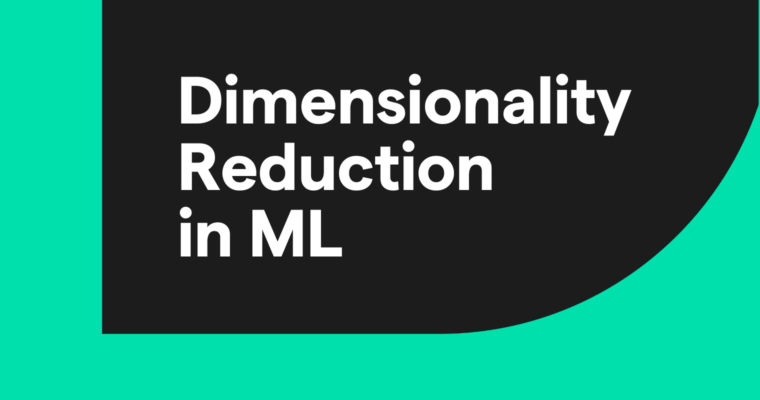
Dimensionality reduction simplifies complex datasets by reducing the number of features while attempting to preserve the essential characteristics, helping machine learning practitioners avoid the “curse of dimensionality” when working with large feature sets. This guide will help you understand what dimensionality reduction is, the techniques used, its applications, and its benefits and drawbacks.
Table of contents
- What is dimensionality reduction?
- Dimensionality reduction techniques
- Applications of dimensionality reduction
- Advantages of dimensionality reduction
- Challenges of dimensionality reduction
What is dimensionality reduction?
Dimensionality reduction refers to a set of techniques used to reduce the number of variables (or dimensions) in a dataset while striving to retain essential patterns and structures. These techniques help simplify complex data, making it easier to process and analyze, especially in the context of machine learning (ML). Depending on how they process the data, dimensionality reduction methods can be either supervised or unsupervised.
A key goal of dimensionality reduction is to simplify data without sacrificing too much valuable information. For example, imagine a dataset consisting of large, high-resolution images, each made up of millions of pixels. By applying a dimensionality reduction technique, you can reduce the number of features (pixels) into a smaller set of new features that capture the most important visual information. This enables more efficient processing while preserving the core characteristics of the images.
While dimensionality reduction helps streamline data, it differs from feature selection, which merely selects from existing features without transformation. Let’s explore this distinction in more detail.
Feature selection vs. dimensionality reduction
Feature selection and dimensionality reduction are both techniques aimed at reducing the number of features in a dataset and the volume of data, but they differ fundamentally in how they approach this task.
- Feature selection: This method selects a subset of existing features from the original dataset without altering them. It ranks features based on their importance or relevance to the target variable and removes those deemed unnecessary. Examples include techniques like forward selection, backward elimination, and recursive feature elimination.
- Dimensionality reduction: Unlike feature selection, dimensionality reduction transforms the original features into new combinations of features, reducing the dimensionality of the dataset. These new features may not have the same clear interpretability as in feature selection, but they often capture more meaningful patterns in the data.
By understanding the difference between these two approaches, practitioners can better decide when to use each method. Feature selection is often used when interpretability is key, while dimensionality reduction is more useful when seeking to capture hidden structures in the data.
Dimensionality reduction techniques
Similar to other ML methods, dimensionality reduction involves various specialized techniques tailored for specific applications. These techniques can be broadly categorized into linear, nonlinear, and autoencoder-based methods, along with others that don’t fit as neatly into these groups.
Linear techniques
Linear techniques, like principal component analysis (PCA), linear discriminant analysis (LDA), and factor analysis, are best for datasets with linear relationships. These methods are also computationally efficient.
- PCA is one of the most common techniques, used to visualize high-dimensional data and reduce noise. It works by identifying the directions (or axes) where data varies the most. Think of it as finding the main trends in a cloud of data points. These directions are called principal components.
- LDA, similar to PCA, is useful for classification tasks in datasets with labeled categories. It works by finding the best ways to separate different groups in the data, like drawing lines that divide them as clearly as possible.
- Factor analysis is often used in fields like psychology. It assumes that observed variables are influenced by unobserved factors, making it useful for uncovering hidden patterns.
Nonlinear techniques
Nonlinear techniques are more suitable for datasets with complex, nonlinear relationships. These include t-distributed stochastic neighbor embedding (t-SNE), isomap, and locally linear embedding (LLE).
- t-SNE is effective for visualizing high-dimensional data by preserving local structure and revealing patterns. For instance, t-SNE could reduce a large, multi-feature dataset of foods into a 2D map where similar foods cluster together based on key features.
- Isomap is ideal for datasets that resemble curved surfaces, as it preserves geodesic distances (the true distance along a manifold) rather than straight-line distances. For example, it could be used to study the spread of diseases across geographic regions, considering natural barriers like mountains and oceans.
- LLE is well suited for datasets with a consistent local structure and focuses on preserving relationships between nearby points. In image processing, for example, LLE could identify similar patches within an image.
Autoencoders
Autoencoders are neural networks designed for dimensionality reduction. They work by encoding input data into a compressed, lower-dimensional representation and then reconstructing the original data from this representation. Autoencoders can capture more complex, nonlinear relationships in data, often surpassing traditional methods like t-SNE in certain contexts. Unlike PCA, autoencoders can automatically learn which features are most important, which is particularly useful when the relevant features aren’t known in advance.
Autoencoders are also a standard example of how dimensionality reduction affects interpretability. The features and dimensions that the autoencoder selects, and then restructures the data into, usually show up as large arrays of numbers. These arrays are not human-readable and often don’t match up with anything the operators expect or understand.
There are various specialized types of autoencoders optimized for different tasks. For example, convolutional autoencoders, which use convolutional neural networks (CNNs), are effective for processing image data.
Other techniques
Some dimensionality reduction methods don’t fall into the linear, nonlinear, or autoencoder categories. Examples include singular value decomposition (SVD) and random projection.
SVD excels at reducing dimensions in large, sparse datasets and is commonly applied in text analysis and recommendation systems.
Random projection, which leverages the Johnson-Lindenstrauss lemma, is a fast and efficient method for handling high-dimensional data. It’s akin to shining a light on a complex shape from a random angle and using the resulting shadow to gain insights into the original shape.
Applications of dimensionality reduction
Dimensionality reduction techniques have a wide range of applications, from image processing to text analysis, enabling more efficient data handling and insights.
Image compression
Dimensionality reduction can be used to compress high-resolution images or video frames, improving storage efficiency and transmission speed. For instance, social media platforms often apply techniques like PCA to compress user-uploaded images. This process reduces file size while retaining essential information. When an image is displayed, the platform can quickly generate an approximation of the original image from the compressed data, significantly reducing storage and upload time.
Bioinformatics
In bioinformatics, dimensionality reduction can be used to analyze gene expression data to identify patterns and relationships among genes, a key factor in the success of initiatives like the Human Genome Project. For example, cancer research studies often use gene expression data from thousands of patients and measure the activity levels of tens of thousands of genes for each sample, resulting in extremely high-dimensional datasets. Using a dimensionality reduction technique like t-SNE, researchers can visualize this complex data in a simpler, human-understandable representation. This visualization can help researchers identify key genes that differentiate gene groups and potentially discover new therapeutic targets.
Text analysis
Dimensionality reduction is also widely used in natural language processing (NLP) to simplify large text datasets for tasks like topic modeling and document classification. For example, news aggregators represent articles as high-dimensional vectors, where each dimension corresponds to a word in the vocabulary. These vectors often have tens of thousands of dimensions. Dimensionality reduction techniques can transform them into vectors with only a few hundred key dimensions, preserving the main topics and relationships between words. These reduced representations enable tasks like identifying trending topics and providing personalized article recommendations.
Data visualization
In data visualization, dimensionality reduction can be used to represent high-dimensional data as 2D or 3D visualizations for exploration and analysis. For example, assume a data scientist segmenting customer data for a large company has a dataset with 60 features for each customer, including demographics, product usage patterns, and interactions with customer service. To understand the different categories of customers, the data scientist could use t-SNE to represent this 60-dimensional data as a 2D graph, allowing them to visualize distinct customer clusters in this complex dataset. One cluster might represent young, high-usage customers, while another could represent older customers who only use the product once in a while.
Advantages of dimensionality reduction
Dimensionality reduction offers several key advantages, including improving computational efficiency and reducing the risk of overfitting in ML models.
Improving computational efficiency
One of the most significant benefits of dimensionality reduction is the improvement in computational efficiency. These techniques can significantly reduce the time and resources needed for analysis and modeling by transforming high-dimensional data into a more manageable, lower-dimensional form. This efficiency is particularly valuable for applications that require real-time processing or involve large-scale datasets. Lower-dimensional data is quicker to process, enabling faster responses in tasks like recommendation systems or real-time analytics.
Preventing overfitting
Dimensionality reduction can be used to mitigate overfitting, a common issue in ML. High-dimensional data often includes irrelevant or redundant features that can cause models to learn noise rather than meaningful patterns, reducing their ability to generalize to new, unseen data. By focusing on the most important features and eliminating unnecessary ones, dimensionality reduction techniques allow models to better capture the true underlying structure of the data. Careful application of dimensionality reduction results in more robust models with improved generalization performance on new datasets.
Challenges of dimensionality reduction
While dimensionality reduction offers many benefits, it also comes with certain challenges, including potential information loss, interpretability issues, and difficulties in selecting the right technique and number of dimensions.
Information loss
Information loss is one of the core challenges in dimensionality reduction. Although these techniques aim to preserve the most important features, some subtle yet meaningful patterns may be discarded in the process. Striking the right balance between reducing dimensionality and retaining critical data is crucial. Too much information loss can result in reduced model performance, making it harder to draw accurate insights or predictions.
Interpretability issues
Like many ML techniques, dimensionality reduction can create interpretability challenges, particularly with nonlinear methods. While the reduced set of features may effectively capture underlying patterns, it can be difficult for humans to understand or explain these features. This lack of interpretability is especially problematic in fields like healthcare or finance, where understanding how decisions are made is crucial for trust and regulatory compliance.
Selecting the right technique and dimensions
Choosing the correct dimensionality reduction method, number of dimensions, and which specific dimensions to retain are key challenges that can significantly impact results. Different techniques work better for different types of data—for example, some methods are more suitable for nonlinear or sparse datasets. Similarly, the optimal number of dimensions depends on the specific dataset and task at hand. Selecting the wrong method or retaining too many or too few dimensions can result in a loss of important information, leading to poor model performance. Often, finding the right balance requires domain expertise, trial and error, and careful validation.






